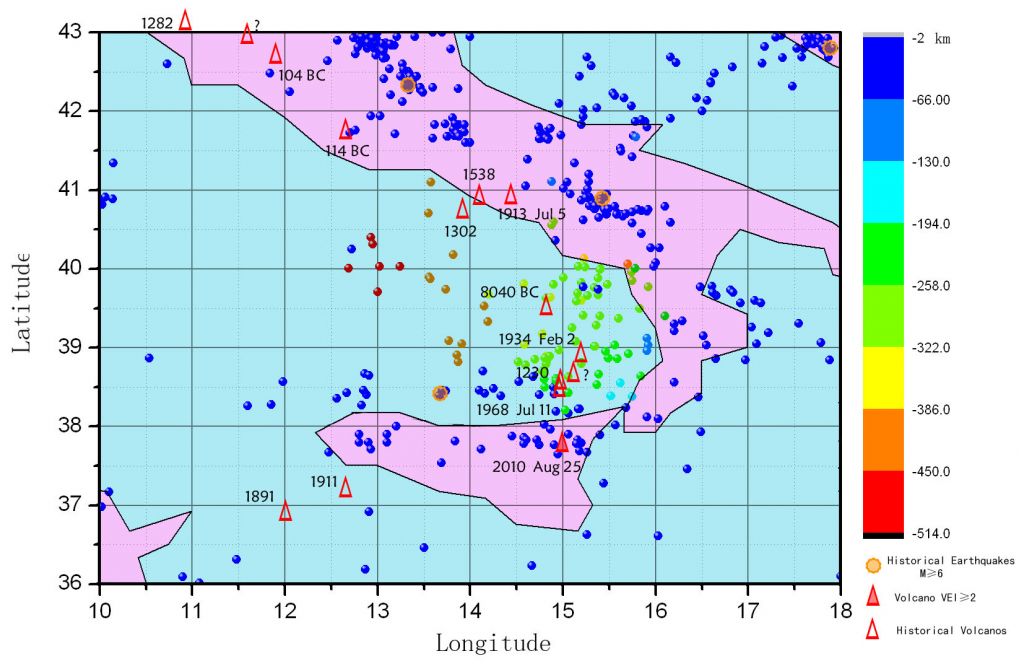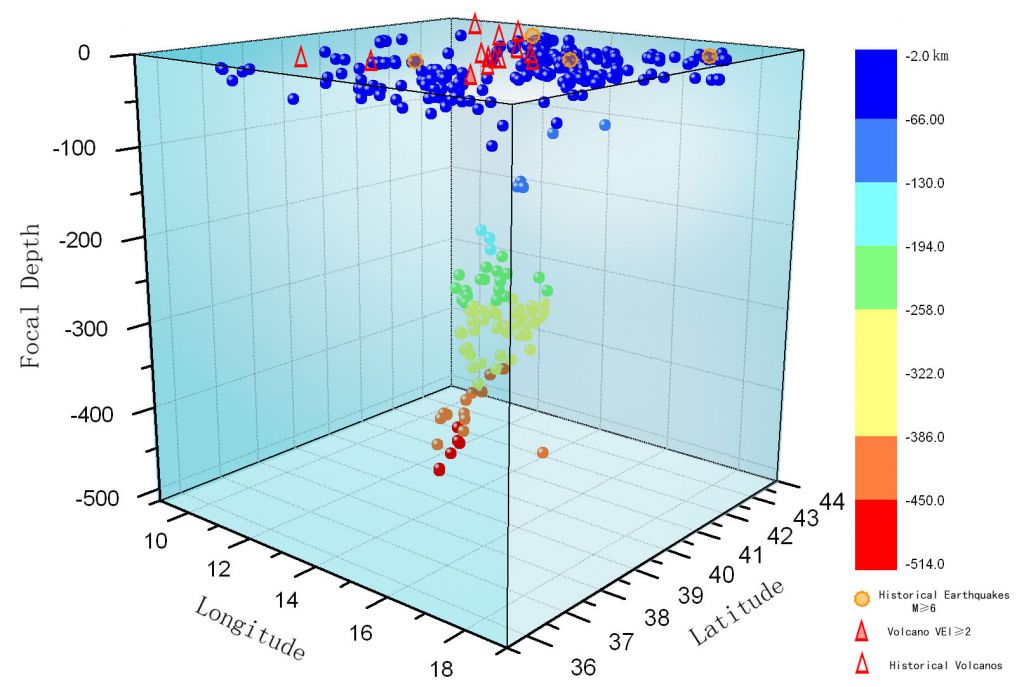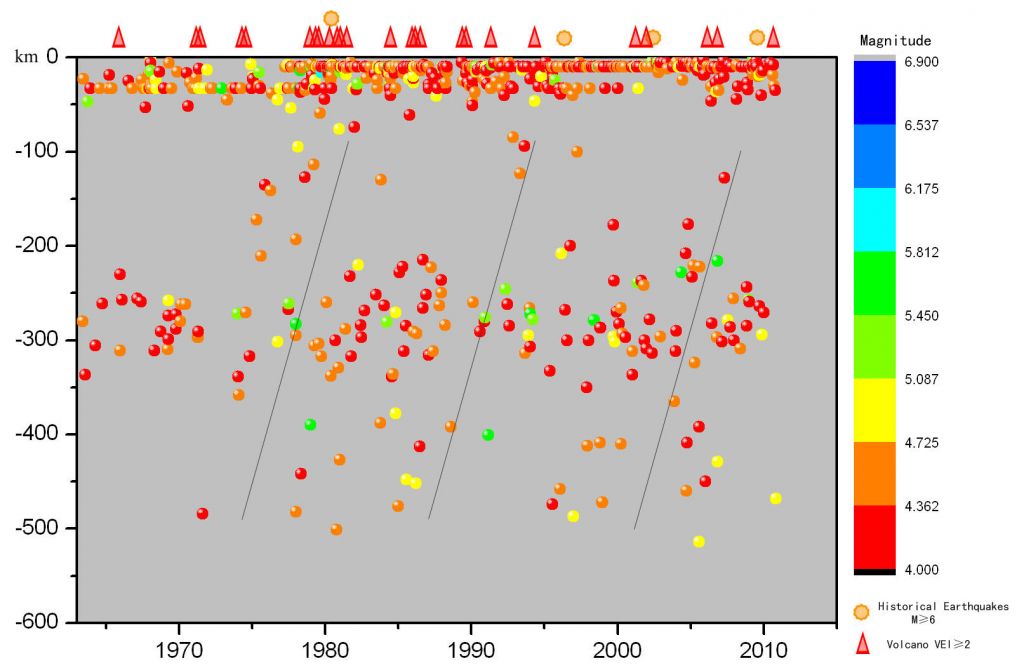博文
Volcano Research in Italy
||
Seismo-Geothermics Applycations:
The Volcano formation cause 1——Volcano Research in Italy
Lijun Chen
Italy is a good place to research the formation of volcano as few active volcanoes but more dormant volcanoes there.
The research zone in Italy locates at the north bank of the Mediterranean Sea (36°~43°N,10°~18°E)。We call it the seismic mantle plume of Italy for the moment, which belongs the main tree of No 20 seismic mantle plume of the Mediterranean Sea.
The basic information of the seismic mantle plume of Italy refers to Figure 1 to 3, Table 1 & 2
Fig 1 is the projection of seismic mantle plume on the earth’s surface, including the earthquakes (M≥4.0) and crustal earthquakes (M≥6.0) during the period from 1963 to May 14 2011 (Chart 1), the Etna and other 14 historical volcanoes including the Vesuvius in Italy which had eruption and VEI≥2 in the past 50 years (Table 2). Fig 2 is the three-dimensional image of earthquakes (M≥4.0) within the seismic mantle plume. Fig 3 is the time series chart of focal depth of earthquakes (M≥4.0) within the seismic mantle plume of Italy.
According to Fig 1 & 2, we could find that the seismic mantle plume of Italy is the type of single tree tectonic with one single root, trunk and tree crown. The max focal depth could be 514km.
Comparing the three figures, we could conclude the findings as follows:
1) According to the division of the seismic mantle plume, such seismic mantle plume is the type with feature of high temp, high pressure and breaking out, which characters are few earthquake activities between 50km and 200km and the heat energy accumulation below 200km could straightly reach the crust and result crustal earthquakes and volcano activities.
2) At the beginning of 1960s, there was nearly no earthquak below 400km and crustal earthquakes and volcano activities was seldom. After 1970s, along with the increase of earthquakes below 400km, the earthquakes between 200km and 400km have became abnormally active, as well as the crustal earthquakes and volcano. This shows that the strong crustal earthquakes and volcano activities are fully affected and restricted by the deep earthquake activities.
3) The surface projection place of Italy seismic mantle plume is at 38~39°N,15~16°E. The Etna is just at the edge of this area. Their close relationship explains that the modern volcano eruption is fully controlled by the seismic mantle plume of Italy.
4) From Fig 1, there is an interesting phenomena that the farther the dormant volcanoes is away the surface projection place,the earlier its last eruption time is. Therefore we could assume that 2000 years before, along the west coast of Italy, there ever exited a large size of lava sac. But due to certain reason, maybe the formation of seismic mantle plume, the lava sac shrank gradually in the direction from northwest to southeast since 100BC, such as to 37~41°N,13~16°E at the beginning of 1900s, and to current 38~39°N,15~16°E after 1970s. Along with the shrinking of lava sac, the historical volcanoes died one after another or became dormant like a lamp without oil.
5) The last eruption of Palinuro at 8040BC near the surface projection place seems to indicate that such shrinking process is complicated, reiterative or maybe diverse on partial structure.
6) Suggest the Italian researcher of earthquake and volcano to pay attention that, if the earthquake activities under 400km become weak, then the shrinking will be continuous with accelerating trend; if the earthquake activity between 200km and 400km expands to northwest, then the historical lava sac has possibility to wake up, especially when earth is rotating itself. To share my such suggestion to the Italian researcher, this article is translated into English now and published in due course.
Hereby thanks to ANSS earthquake catalogue on http://www.ncedc.org, and to GVP monthly volcanic Bulletin on http://www.volcano.si.edu/.
(The 1st draft, 2011.6.6)

Fig.1 The projection of Italy seismic mantle plume on the earth’s surface.

Fig.2 The three-dimensional image of earthquakes (M≥4.0) within Italy seismic mantle plume.

Fig.3 The time series chart of focal depth of earthquakes (M≥4.0) within Italy seismic mantle plume.
Table 1 The catalogue of Earthquake M≥6 in Italy(1963-2011.5.14)
|
Earthquake YMD |
Latitude |
Longitude |
Magnitude |
Focal Depth |
|
19801123 |
40.91 |
15.36 |
6.9 |
10 |
|
19960905 |
42.80 |
17.93 |
6.0 |
10 |
|
20020906 |
38.38 |
13.70 |
6.0 |
5 |
|
20090406 |
42.33 |
13.33 |
6.3 |
8 |
Table 2 The Volcano Eruption History Record in Italy in Holocene.
|
Volcano |
Country |
Coordinate |
Last Known Eruption |
Max VEI |
|
Alban Hills |
Italy |
41.73°N, 12.70°E |
114 BC |
|
|
Amiata |
Italy |
42.90°N, 11.63°E |
? |
|
|
Campi Flegrei |
Italy |
40.827°N, 14.139°E |
1538 Sep 29 |
5 |
|
Campi Flegrei Mar Sicilia |
Italy |
37.10°N *, 12.70°E |
1911 Sep 30 |
3 |
|
Etna |
Italy |
37.734°N, 15.004°E |
2010 Aug 25 1787 122 BC |
3 4 5 |
|
Ischia |
Italy |
40.73°N, 13.897°E |
1302 Jan 18 |
3 |
|
|
Italy |
43.25°N, 10.87°E |
1282 (in or before) |
3? |
|
Lipari |
Italy |
38.48°N, 14.95°E |
1230 ± 40 years |
|
|
Palinuro |
Italy |
39.48°N, 14.83°E |
8040 BC ± 100 years |
|
|
Panarea |
Italy |
38.63°N, 15.07°E |
? |
|
|
Pantelleria |
Italy |
36.77°N, 12.02°E |
1891 Dec |
1 |
|
Stromboli |
Italy |
38.789°N, 15.213°E |
1934 Feb 2 |
3 |
|
Vesuvius |
Italy |
40.821°N, 14.426°E |
1913 Jul 5 472 AD Nov 5 203 AD 79 AD Oct 24 (?) |
3 5 P** 5? |
|
Vulcano |
Italy |
38.404°N, 14.962°E |
1968 Jul 11 |
4 |
|
Vulsini |
Italy |
42.60°N, 11.93°E |
104 BC |
|
** Eruptions associated with caldera collapse are normally large (probably VEI >4), and those for which data are lacking to assign a specific VEI are indicated by a "C" in the VEI column. Likewise, Plinian eruptions in the absence of more quantitative data are marked with a "P" in the VEI column.
https://blog.sciencenet.cn/blog-552558-457141.html
上一篇:地震地热说应用:火山成因之7——北美洲的火山研究(修订稿)
下一篇:地震地热说应用:火山成因之8——白令海的火山研究